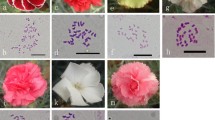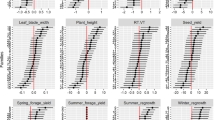Abstract
A comparative study of the effect of tetraploidy in three varieties of green gram (Phaseolus aureus Roxb.) and selection of plants with high, medium and low vigour showed that the reduced leaflet size and height at the time of flowering can be considerably improved by selection. It appeared that the diploid level can be approached or even exceeded.
The reduced fruit setting can also be improved considerably but not the size of fruits and number of seeds per pod. The increased seed weight was further improved in two varieties. The increase in protein content of the tetraploid seeds was greatest in the variety with the lowest protein content at the diploid level.
Though for vegetative growth selection alone would suffice to bring the tetraploids up to the diploid level, if not higher, the reduced fruit and seed setting, though responding well to selection, are unlikely to be overcome unless other breeding methods are introduced.
Similar content being viewed by others
References
KuckuckH. and LevanA., Vergleichende Untersuchungen an diploiden and tetraploiden Leinsippen und an tetraploiden Kreuzungsnachkommenschaften nach vieljähriger Selektion. Züchter 21 (1951): 195–205.
KumarL. S. S., A comparative study of autotetraploid and diploid types in mung (Phaseolus radiatus L.) Proc. Ind. Acad. Sci., B, 21 (1945): 266–268.
KumarL. S. S. and AbrahamA., Induction of polyploidy in crop plants. Curr. Sci. 11 (1942): 112–113.
LevanA., Plant breeding by induction of polyploidy and some results in clover. Hereditas 28 (1942): 245–246.
Müntzing, A., Experiences from work with induced polyploids in cereals. Svalöf 1886–1946. History and present problems, Lund, 1948: 324–337.
MüntzingA., Cyto-genetic properties and practical value of tetraploid rye. Hereditas 37 (1951): 17–84.
NoggleG., The physiology of polyploidy in plants. 1. Review of the literature. Lloydia 9 (1946): 155–173.
PalB. P. and RamanujamS., Plant breeding and genetics at the Imperial Agricultural Research Institute. Indian Journ. Gen. Pl. Breeding 4 (1944): 43–53.
ParthasarathyN. and RajanS. S., Studies in the fertility of autotetraploids of Brassica campestris var. toria. Euphytica 2 (1953): 25–36.
SchlösserL. A., Über das Fertilwerden autoploiden Leinsippen. Züchter 16 (1944): 3–8.
Author information
Authors and Affiliations
Rights and permissions
About this article
Cite this article
Sen, N.K., Murty, A.S. Effects of selection in tetraploid green gram varieties. Euphytica 9, 235–242 (1960). https://doi.org/10.1007/BF00022228
Received:
Issue Date:
DOI: https://doi.org/10.1007/BF00022228




